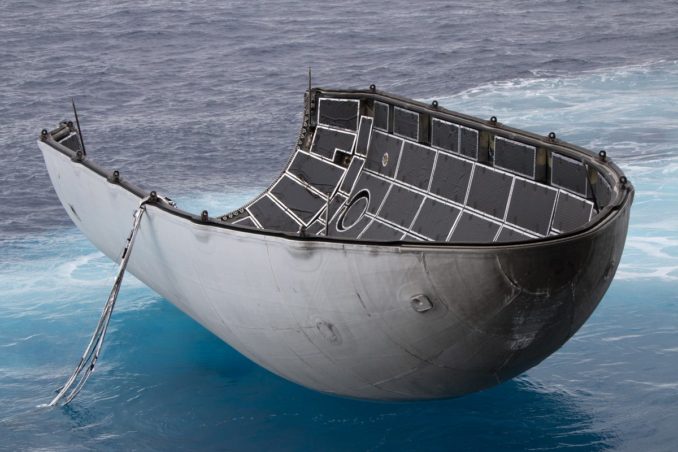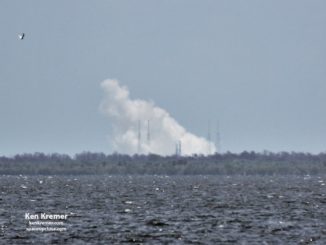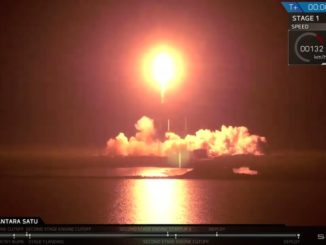
Photos released by SpaceX this week show how close the company’s payload fairing retrieval ship got to catching two halves of a nose shroud jettisoned from a Falcon 9 rocket that launched May 22 from Vandenberg Air Force Base, California.
SpaceX is attempting to recover payload fairings from Falcon 9 launches to reuse the components, which cover satellites during final countdown preparations and the first few minutes of flight through the dense lower atmosphere. Once the rocket climbs into the rarefied upper atmosphere, it jettisons the fairing, which falls away from the launcher in two pieces like a clamshell.
Engineers have fitted Falcon 9 payload shrouds with cold gas control thrusters and parachutes to steer the fairing halves toward a soft landing at sea. A fast-moving vessel named Mr. Steven equipped with a large net suspended between four metal posts — dubbed a “catcher’s mitt” by some SpaceX engineers — is designed to sail to the fairing’s expected landing point to catch the shroud.
New images captured after the most recent Falcon 9 launch May 22 show the rocket’s fairing descending into the Pacific Ocean after separating from the launcher around three minutes after liftoff with five Iridium communications satellites and a pair of Earth science satellites for NASA and GFZ, a German research institution.
Both fairing halves deployed their steerable parafoils and splashed down in the Pacific, with the closest half coming within around 50 meters, or about 160 feet, from Mr. Steven, SpaceX said in a tweet.

SpaceX aims to eventually recover and reuse the payload fairings, similar to the way the company now lands and reuses Falcon 9 first stage boosters. Ultimately, the reuse initiative should substantially cut launch costs, according to Elon Musk, SpaceX’s founder and chief executive.
With the latest upgrades, the Falcon 9’s fairing is “designed for full recoverability,” Musk told reporters in a May 10 conference call.
But engineers want to retrieve the fairing with a ship, rather than allowing the shroud to fall into the sea, where salt water can damage or contaminate sensitive parts.
“In future flights, we’re confident that fairing reuse will be effective, which is a big deal because each one of those fairings cost about $6 million to build, and it represents a significant percentage of the airframe of the rocket,” Musk said.
SpaceX’s current fairing recovery boat, Mr. Steven, is based at the Port of Los Angeles for launches from Vandenberg, a military base on California’s Central Coast. The company is expected to eventually deploy multiple vessels for fairing recoveries after launches from California and Florida.

Payload fairings from Falcon 9 launches from Cape Canaveral have also carried recovery gear, but SpaceX has not yet attempted a retrieval with a net-outfitted boat in the Atlantic Ocean.
Musk released an image of one half of a fairing from the April 18 launch of NASA’s Transiting Exoplanet Survey Satellite on Instagram last month, showing the shroud under its parafoil at sunset over the Atlantic Ocean following blastoff from Cape Canaveral.
The most recent upgrades to the Falcon 9 fairing, intended to make it easier to recover and reuse, debuted in February with the launch of the Spanish-owned Paz radar observation satellite and two pathfinder craft for SpaceX’s planned Starlink broadband network.
Speaking to reporters last month, Musk said the first stage of the Falcon 9 rocket comprises about 60 percent of the cost of a launch, with the upper stage responsible for 20 percent, and the fairing another 10 percent. The remaining 10 percent of the cost of a Falcon 9 mission come from charges stemming from launch operations, propellant and other processing expenses, Musk said.

According to Musk, SpaceX is in the early stages of studying the feasibility of retrieving the second stage from Falcon 9 rocket launches. The upper stage typically burns up during re-entry into Earth’s atmosphere after depositing its payload into orbit.
Such a feat would require the addition of a heat shield because the second stage must come back to Earth from orbital velocity — much faster speeds than encountered by the first stage — adding weight to the rocket and reducing the Falcon 9’s payload lift capacity.
“I’m certain we can achieve full reusability of the upper stage,” Musk said. “The question is what the mass penalty is.”
SpaceX plans to gather data on upcoming flights on temperatures experienced by Falcon 9 upper stages during re-entry.
The temperature, health and altitude information will be transmitted to engineers on the ground through the Iridium data relay constellation, Musk said.
If SpaceX is able to reuse the fairing and second stage, Musk said the “long-term marginal cost per flight” for the Falcon 9 rocket could fall as low as $5 million or $6 million.
“We still have a bunch of fixed costs to cover which need to be divided over a number of flights, and we need to try to recover the development costs of recovery and pay for BFR (Big Falcon Rocket) and pay for the Starlink constellation,” Musk said.
Musk said he expects to see a steady reduction in Falcon 9 launch prices. SpaceX currently charges about $50 million for a Falcon 9 launch with a reused first stage, down from the roughly $60 million listed on the company’s website.
Email the author.
Follow Stephen Clark on Twitter: @StephenClark1.



